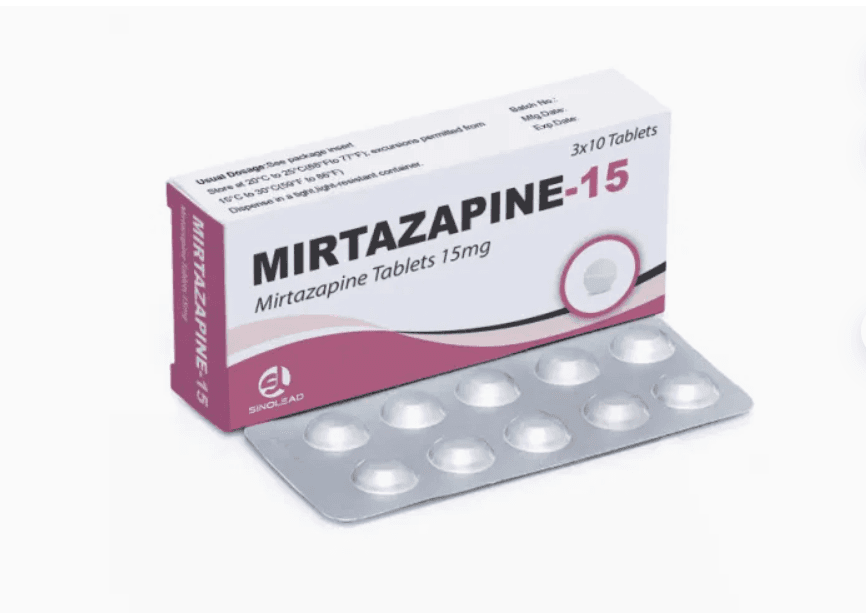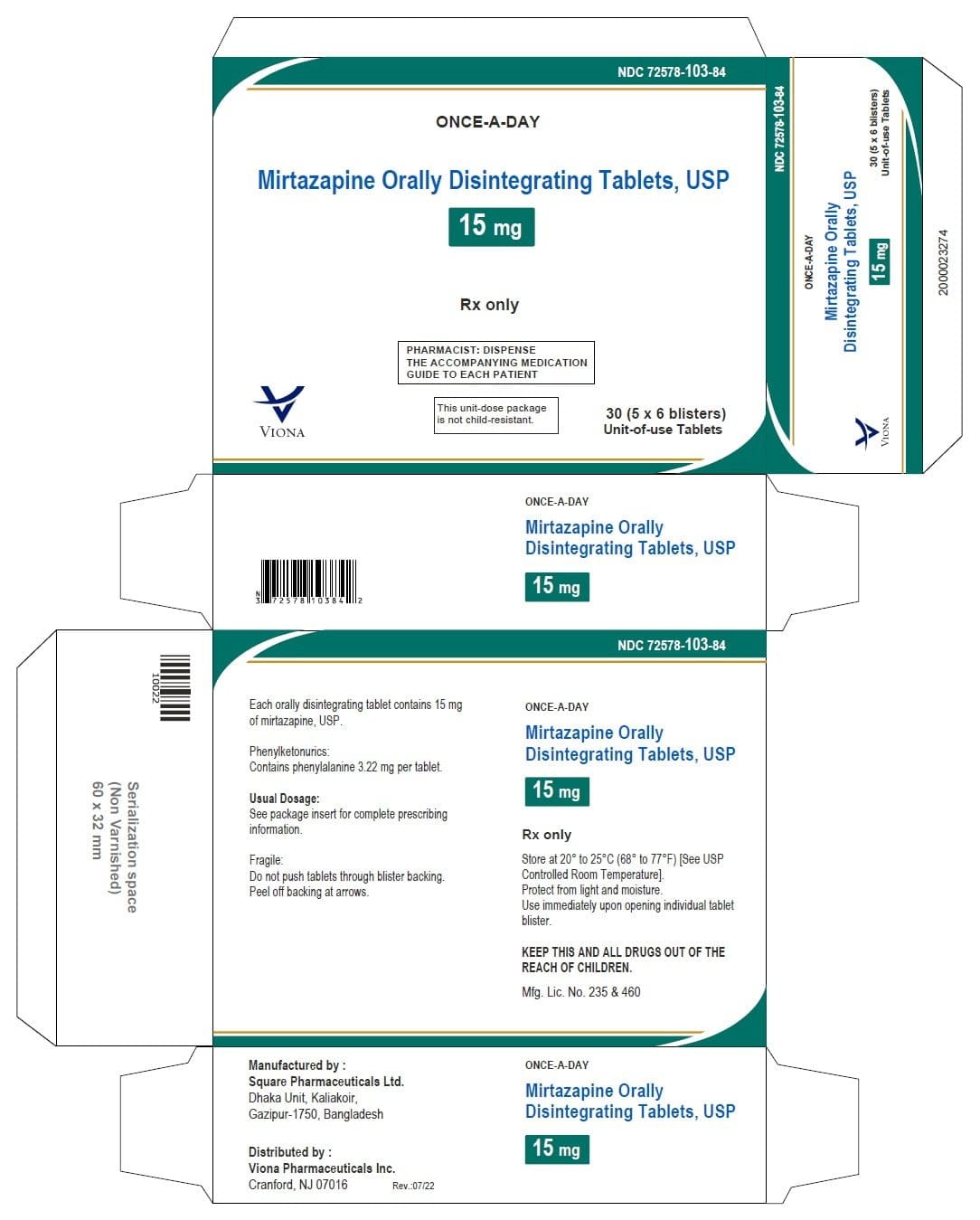Shipping with this method takes 3-5 days
Mirtazapine Tablets for Depression
Price range: $28.99 through $82.99
Secure Encrypted Payments
Mirtazapine is a prescription antidepressant used for major depressive disorder in adults. It works on central nervous system receptors that influence mood and sleep. This page explains what it is, how it is taken, and how to order safely.
What Mirtazapine Is and How It Works
We provide US delivery from Canada with careful pharmacy checks. Some patients look for mirtazapine without insurance; this guide outlines key facts so you can plan your care and budget. YouDrugstore is a licensed Canadian pharmacy in Manitoba. Pharmacists review prescriptions before dispensing.
This medicine is a tetracyclic antidepressant. It enhances noradrenergic and serotonergic activity by antagonizing central alpha-2 adrenergic receptors. It also blocks certain serotonin receptors (5-HT2 and 5-HT3) while sparing 5-HT1, which may support mood. Histamine H1 receptor effects can cause drowsiness, especially early in treatment.
For an overview of the condition it treats, see our page on Depression.
Who It’s For
This treatment is indicated for adults with major depressive disorder as diagnosed by a qualified prescriber. It may be considered when a patient has not tolerated or responded to other antidepressants, or when nighttime dosing and sedation are acceptable.
It is not suitable for people who are currently taking or recently took an MAOI, or who have a known hypersensitivity to any component. Use caution in those with severe liver or kidney impairment, a history of mania or hypomania, angle-closure glaucoma risk, or seizure disorders. Discuss risks if you are pregnant, planning pregnancy, or breastfeeding. Learn more about related conditions in Generalized Anxiety Disorder and What Are The Best Medications.
Dosage and Usage
Follow your prescriber’s directions and the official label. This medicine is usually taken once daily, often in the evening due to drowsiness. Tablets should be swallowed whole with water and can be taken with or without food. Your clinician may adjust the dose at intervals based on response and tolerability.
Many adults start on lower strengths and are monitored before any changes are made. Never split or crush orally disintegrating tablets. Do not make any dose changes without guidance. Typical practice is to reassess mood, sleep, and side effects at follow-up visits. If you have questions about timing or meals, ask your healthcare professional.
People prescribed mirtazapine 15 mg tablets should use them exactly as directed on the label. If you experience excessive daytime sleepiness or other issues, contact your prescriber to discuss options rather than altering your schedule on your own.
Strengths and Forms
Availability can vary. Common tablet strengths include 7.5 mg, 15 mg, 30 mg, and 45 mg. Standard film-coated tablets are most common. Orally disintegrating tablets may be available in some markets; your pharmacist can advise on specific stock.
Patients who need a different swallow experience can ask about dispersible options. For those continuing therapy, your prescriber may choose to maintain or adjust a strength based on effect and tolerability. Many adults ultimately use stable daily dosing once a response is established. If you need a different tablet size for precise dosing, your prescriber will determine the most appropriate form. Some patients use mirtazapine 30 mg tablets as part of their maintenance plan, while others remain on lower or higher amounts as clinically appropriate.
Missed Dose and Timing
If you miss a dose, take it when you remember unless it is close to the next dose. If it is almost time for the next dose, skip the missed dose and resume your regular schedule. Do not double up to make up for a missed tablet. Because this medicine may cause drowsiness, many people take it at bedtime. Consistent timing helps maintain steady levels.
Storage and Travel Basics
Keep tablets in the original packaging, protected from moisture and excessive heat. Store out of reach of children and pets. Avoid bathrooms and car gloveboxes due to humidity and temperature swings. When traveling, carry your medicine in your hand luggage with your prescription label. A copy of your prescription or a summary from your clinician can help at security checks.
Use a reminder system if you cross time zones. If you need guidance on adjusting your schedule during travel, your prescriber can advise. For more mental health resources, see our Mental Health category.
Benefits
This therapy can improve core symptoms of depression, including low mood and poor sleep. Nighttime dosing may align with drowsiness, which some patients find helpful for sleep onset. The once-daily schedule is simple. Tablets are easy to store and take without special equipment.
Effects on specific symptoms vary by individual. Regular follow-up supports safe use and dose adjustments when appropriate. Read the patient leaflet for a full list of potential effects and cautions. For context on treatment choices, see What Is The Best Treatment.
Side Effects and Safety
- Common: drowsiness, increased appetite, weight gain
- Common: dry mouth, constipation, dizziness
- Less common: abnormal dreams, edema, cholesterol changes
Serious but rare risks include severe low white blood cell counts, serotonin syndrome (especially with other serotonergic drugs), angle-closure glaucoma, and mood changes such as agitation or mania. There is a known risk of suicidal thoughts and behaviors in young people starting antidepressants. Alcohol and other sedatives can increase drowsiness. If you take insulin or sulfonylureas, monitor for low blood sugar symptoms when mood and eating patterns change.
For more on managing adverse effects, read Fluoxetine Side Effects for general principles that often apply across antidepressants.
Drug Interactions and Cautions
Do not use with MAO inhibitors, or within 14 days of stopping an MAOI. Combining with other serotonergic agents (for example, SSRIs, SNRIs, triptans, linezolid, or methylene blue) can raise the risk of serotonin syndrome. CNS depressants, benzodiazepines, opioids, and alcohol may increase sedation. Use caution with drugs that affect heart rhythm or lower seizure threshold.
Tell your clinician about all medicines, supplements, and herbal products you take, including St. John’s wort and tryptophan. Report any unexpected agitation, fever, tremor, or stiff muscles immediately. For broader mental health safety topics, see Abilify And Alcohol.
What to Expect Over Time
Some people notice early changes in sleep and appetite. Mood improvement may build with continued use. Your prescriber will review your response and side effects at follow-up visits. If therapy is continued long term, the goal is to support remission and prevent relapse while minimizing unwanted effects.
Staying consistent with daily dosing, lifestyle routines, and follow-up helps keep treatment on track. For seasonal patterns and coping strategies, see How To Treat Seasonal. For a look at another antidepressant’s mechanism, read The Science Behind Wellbutrin.
Compare With Alternatives
SSRIs are common first-line options. If you and your prescriber consider an SSRI, Sertraline is one frequently used choice. SNRIs offer another path when indicated; one option is Venlafaxine Xr. Your history, side effect priorities, and coexisting conditions guide selection.
Pricing and Access
We highlight mirtazapine Canadian pricing to help you compare options. To view current pricing, sign in and upload your valid prescription. You can also see typical cash-pay savings compared with many local retail quotes. We offer US shipping from Canada with clear tracking. Looking for deals? See our Promotions page for current offers when available. Encrypted checkout helps protect your information.
Availability and Substitutions
Stock can vary by strength and manufacturer. If a specific tablet is unavailable, your prescriber may recommend a therapeutically equivalent alternative. Pharmacists can coordinate with your clinician on suitable substitutions when permitted by your prescription and local regulations. We do not provide restock dates.
Patient Suitability and Cost-Saving Tips
This medicine may suit adults who prefer once-daily dosing at night and who have not tolerated activating antidepressants. It may be less suitable for those who must avoid sedation or who are at risk of weight gain-related complications. People with complex regimens should review all medicines for interaction risks.
To save on costs, consider multi-month fills if your prescriber agrees. Use refill reminders so you do not run out unexpectedly. Keeping a consistent dose can reduce clinic visits for changes. If you change insurance or address, update your profile to avoid delays. Ask your clinician whether generic options meet your needs.
Questions to Ask Your Clinician
- Starting dose and timing: what schedule fits my routine
- What to watch: which side effects should I report early
- Interactions: which medicines or supplements should I avoid
- Follow-up: when should we reassess response
- Long-term plan: how long might maintenance last
- Alternatives: what options exist if sedation is an issue
Authoritative Sources
Health Canada DPD: Mirtazapine
Ready to buy mirtazapine online? Place your order with prescription, and we’ll handle the rest. Ships from Canada to US with prompt shipping and temperature-controlled handling when required. This page is informational and not a substitute for medical advice.
Express Shipping - from $25.00
Prices:
- Dry-Packed Products $25.00
- Cold-Packed Products $35.00
Shipping Countries:
- United States (all contiguous states**)
- Worldwide (excludes some countries***)
Standard Shipping - $15.00
Shipping with this method takes 5-10 days
Prices:
- Dry-Packed Products $15.00
- Not available for Cold-Packed products
Shipping Countries:
- United States (all contiguous states**)
- Worldwide (excludes some countries***)
How does this antidepressant work in the body?
It increases noradrenergic and serotonergic activity by blocking central alpha-2 adrenergic autoreceptors and heteroreceptors. It also antagonizes certain serotonin receptors (5‑HT2 and 5‑HT3) while sparing 5‑HT1, which may support mood. Histamine H1 receptor effects contribute to sedation, so many people take it at night. Always follow the FDA or Health Canada label and your prescriber’s guidance for safe use.
When is the best time to take a dose?
Because drowsiness is common, many adults take their daily tablet in the evening. Taking it at the same time each day can help maintain steady levels. Your prescriber may adjust timing if daytime sleepiness becomes an issue. If you have shift work or jet lag, ask about strategies for keeping a consistent schedule during travel.
What should I do if I miss a dose?
If you forget a dose, take it when you remember unless it is close to the next one. If it is almost time for your next dose, skip the missed dose and resume your regular schedule. Do not double up. If you miss doses often, set reminders or speak with your clinician about adherence tools that fit your routine.
Which side effects are most common?
Drowsiness, increased appetite, weight gain, dry mouth, constipation, and dizziness are commonly reported. Most effects are mild to moderate and may improve with time. Rare but serious risks include severe low white blood cell counts and serotonin syndrome, especially with interacting medicines. Contact your clinician if you notice concerning symptoms.
Can I drink alcohol while taking it?
Alcohol can increase sedation and impair coordination when combined with this medicine. Many clinicians advise limiting or avoiding alcohol, especially during initiation or dose changes. If you choose to drink, discuss safe limits with your healthcare professional and avoid activities that require alertness until you know how you respond.
How long does it take to feel better?
Some people notice improvements in sleep or appetite earlier, while mood changes may take longer. Antidepressant response is gradual and varies. Your clinician will review your progress and side effects at follow-up visits and decide whether to continue, adjust, or consider alternatives. Keep taking it as directed unless your prescriber advises otherwise.
Is a prescription required to purchase this medication?
Yes, a valid prescription is required. A pharmacist will verify your prescription before dispensing. For cross-border orders, make sure your details match your prescriber’s information to avoid processing delays. Your carton should remain in its original packaging for travel and storage safety.

